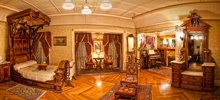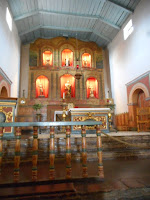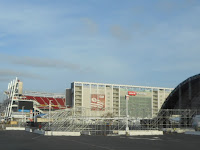 We
visited the home of Sarah L. Winchester, the widow of William Wirt Winchester,
son and heir to the company that manufactured the Winchester repeating rifle.
Her infant daughter who died in 1866 followed by her husbands, mothers and
fathers deaths 15 years later, Sarah felt estranged in her New Haven
Connecticut home. She decided to move west on the advice of a spiritualist and
bought a quaint family farm in San Jose.
We
visited the home of Sarah L. Winchester, the widow of William Wirt Winchester,
son and heir to the company that manufactured the Winchester repeating rifle.
Her infant daughter who died in 1866 followed by her husbands, mothers and
fathers deaths 15 years later, Sarah felt estranged in her New Haven
Connecticut home. She decided to move west on the advice of a spiritualist and
bought a quaint family farm in San Jose. Sarah
bought a ranch and home and began to build. She had been told that her multiple
family tragedies were the result of the dead souls from the effects of the
Winchester repeating rifle reaching back from the beyond. She was told that if
she moved west and built a home, and never completed it, that she could escape
these demons. So apparently, that is what she set out to do.
Sarah
bought a ranch and home and began to build. She had been told that her multiple
family tragedies were the result of the dead souls from the effects of the
Winchester repeating rifle reaching back from the beyond. She was told that if
she moved west and built a home, and never completed it, that she could escape
these demons. So apparently, that is what she set out to do.
The home
is bizarre. Doors in the home may exit to no balcony or anything but space.
Staircases often lead up just to end at a ceiling with no way out. While it is
immense, there is no feel of “home” here, just a lot of rooms patched together.
 From the
day she arrived she had a construction crew on site working 7 days a week so
that the home was continuously under construction as she had been advised by
her mediums. Before she died 38 years later, her construction fanaticism
managed to turn the quaint 1,200 foot farm home into a bizarre 24,000 square
foot mansion. Because construction was the goal, not functionality or design,
the results were often strange, unexpected. For example, there were 7
commercial scale kitchens in the mansion and we toured them all. We visited the
séance room and many of the bedrooms that Sarah slept in. It was said that she
slept in a different one of the 40 bedrooms every night in order to hopefully
confuse the demons that may be after her.
From the
day she arrived she had a construction crew on site working 7 days a week so
that the home was continuously under construction as she had been advised by
her mediums. Before she died 38 years later, her construction fanaticism
managed to turn the quaint 1,200 foot farm home into a bizarre 24,000 square
foot mansion. Because construction was the goal, not functionality or design,
the results were often strange, unexpected. For example, there were 7
commercial scale kitchens in the mansion and we toured them all. We visited the
séance room and many of the bedrooms that Sarah slept in. It was said that she
slept in a different one of the 40 bedrooms every night in order to hopefully
confuse the demons that may be after her. At the
height of its construction the mansion towered to 7 stories. However, being
adjacent to the San Andreas Fault, it was the lucky recipient of many
earthquakes, one of which was successful in lowering it to 4 stories by placing
its famed tower into one of its two basements. It was during that particular
earthquake that staff indicated that Sarah was actually trapped in one of the
bedrooms. Since the staff never knew where she would chose to sleep it took
them several hours to locate her and free her from her potential tomb.
At the
height of its construction the mansion towered to 7 stories. However, being
adjacent to the San Andreas Fault, it was the lucky recipient of many
earthquakes, one of which was successful in lowering it to 4 stories by placing
its famed tower into one of its two basements. It was during that particular
earthquake that staff indicated that Sarah was actually trapped in one of the
bedrooms. Since the staff never knew where she would chose to sleep it took
them several hours to locate her and free her from her potential tomb. We
visited Mission San Juan Bautista. The 15th of the 21 California
missions it was founded by Father Fermin Francisco de Lausen on June 24, 1797.
We
visited Mission San Juan Bautista. The 15th of the 21 California
missions it was founded by Father Fermin Francisco de Lausen on June 24, 1797.
Named for
Saint John the Baptist, baptizer of Jesus and patron saint of monks, the
mission is the largest of the 21 Spanish missions along the Camino Real. The
extent of the scale of the mission was such that it took the local Native
Americans over 15 years just to build the 4 foot thick walls of this mission.
 This must
be the closest mission to the San Andreas Fault. The Fault literally runs
within 20 or 30 feet along the length of the main chapel. Also, remains of the
original Camino Real also run atop the Fault alongside the chapel.
This must
be the closest mission to the San Andreas Fault. The Fault literally runs
within 20 or 30 feet along the length of the main chapel. Also, remains of the
original Camino Real also run atop the Fault alongside the chapel.
Across
the street from the mission is the historic Plaza Hotel. Several buildings from
the 1800’s in the town of San Juan Bautista have been salvaged and restored by
the State of California as a historical park. Again, economic failure of this
small town is what resulted in these old buildings not being remodeled or
removed for newer development. Once we finished with the mission and thought
about touring the State Historic Park many hundreds of screaming grade school
kids had descended. The ranger told us that was the routine during the week –
dozens of school buses show at opening time. She suggested we might want to
return after lunch – we decided to take a pass.
 We
stumbled on one last interesting thing about Mission San Juan Bautista. All the
missions have an attached museum, usually in the buildings where the padres
lived, ate and worshipped. At the far back of this mission museum we found
Alfred Hitchcock’s death mask on display, with no real explanation anywhere of
why it was there. We sought out a docent and learned that much of the Hitchcock
thriller Vertigo had actually been filmed on site in the 1950’s. Maybe they
were here filming when the Woman and I were being born!
We
stumbled on one last interesting thing about Mission San Juan Bautista. All the
missions have an attached museum, usually in the buildings where the padres
lived, ate and worshipped. At the far back of this mission museum we found
Alfred Hitchcock’s death mask on display, with no real explanation anywhere of
why it was there. We sought out a docent and learned that much of the Hitchcock
thriller Vertigo had actually been filmed on site in the 1950’s. Maybe they
were here filming when the Woman and I were being born! We
discovered another agricultural capital of the world in Gilroy California. While
at the Rose Parade we met a couple who lived in Gilroy and told us about its
unique place in the world. While I can’t figure out how to verify this, Gilroy
is the self-proclaimed Garlic Capital of the World. I have not been able to find
stats like I did for the Castroville area to prove the claim, but we did ogle
some garlic farms and sampled some garlic delicacies, including the garlic
wine. We drew the line, however, at the garlic ice cream. Maybe we should have
drawn the line before we sampled the garlic wine as well.
We
discovered another agricultural capital of the world in Gilroy California. While
at the Rose Parade we met a couple who lived in Gilroy and told us about its
unique place in the world. While I can’t figure out how to verify this, Gilroy
is the self-proclaimed Garlic Capital of the World. I have not been able to find
stats like I did for the Castroville area to prove the claim, but we did ogle
some garlic farms and sampled some garlic delicacies, including the garlic
wine. We drew the line, however, at the garlic ice cream. Maybe we should have
drawn the line before we sampled the garlic wine as well. We visited
Mission Santa Clara de Asis. The 8th mission founded by Padre Serra
on January 12, 1977, the mission is now in the center of the campus of the
University of Santa Clara. As we had to park on the periphery – as on many
large campuses there is limited vehicle traffic allowed inside – we asked a
group of students if they could point us in the direction of the mission. It
was funny - they had to think about it a bit, but then they said “Oh, you mean
the church?” and then they were able to get us headed the right way.
We visited
Mission Santa Clara de Asis. The 8th mission founded by Padre Serra
on January 12, 1977, the mission is now in the center of the campus of the
University of Santa Clara. As we had to park on the periphery – as on many
large campuses there is limited vehicle traffic allowed inside – we asked a
group of students if they could point us in the direction of the mission. It
was funny - they had to think about it a bit, but then they said “Oh, you mean
the church?” and then they were able to get us headed the right way. Being
surrounded by a university campus with hundreds of folk walking around, this
mission did not have the same kind of remote, historic feel of many we had seen
so far. However, once we got inside where it was peaceful and quiet, the beauty
revealed itself to us. Named for Saint Clare of Assisi, founder of the Order of
Poor Clares, this mission was located near the Guadalupe River and the largest
population of Natives in all California.
Being
surrounded by a university campus with hundreds of folk walking around, this
mission did not have the same kind of remote, historic feel of many we had seen
so far. However, once we got inside where it was peaceful and quiet, the beauty
revealed itself to us. Named for Saint Clare of Assisi, founder of the Order of
Poor Clares, this mission was located near the Guadalupe River and the largest
population of Natives in all California. We couldn’t
help ourselves when we were this close to the action. Because of the massive
preparations for the Superbowl, Levis Stadium tours have unfortunately been
suspended. But that didn’t stop us from stopping by just to take in the sight.
We couldn’t have guessed just how many scaffolds and temporary buildings we
would see – the entire area surrounding the stadium was littered with them. The
money that must be involved here is unimaginable!
We couldn’t
help ourselves when we were this close to the action. Because of the massive
preparations for the Superbowl, Levis Stadium tours have unfortunately been
suspended. But that didn’t stop us from stopping by just to take in the sight.
We couldn’t have guessed just how many scaffolds and temporary buildings we
would see – the entire area surrounding the stadium was littered with them. The
money that must be involved here is unimaginable!
Before
moving on we visited Mission San Jose, the 14th mission founded June
11, 1797. This mission was another founded by Fray Fermin Francisco de Lausen,
and still incorporates some of the original chapel buttresses in its
construction.
Talk to
you soon!
No comments:
Post a Comment